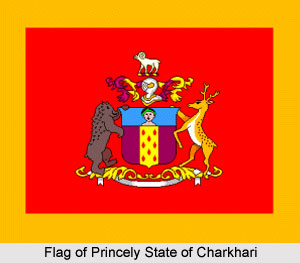 The Princely State of Charkhari was one of the 11 Gun Salute states of India during the rule of the British Empire in India. During the early 19th century, the region was appointed as one of the princely states of India under the indirect rule of the British administration. The region was scattered over a total area of 880 sq miles and comprised of a total population of 123,594 in the year 1941. Charkhari state included around 329 villages and 1 town in 1941 and was situated in Bundelkhand. The land consisted of 3 major blocks of territory and several enclaves. It was completely bounded by British territory of the United Provinces of Agra and Oudh to the north of Chhatarpur. It was bordered by Chhatarpur in the west; by the regions of Ajaigarh in the south; by Panna in the north; and by the British territory of the United Provinces of Oudh and Agra in the east. Another key tract was enclaved between Chhatarpur in the east and north, Bijawar in the south, and by Orchha in the west.
The Princely State of Charkhari was one of the 11 Gun Salute states of India during the rule of the British Empire in India. During the early 19th century, the region was appointed as one of the princely states of India under the indirect rule of the British administration. The region was scattered over a total area of 880 sq miles and comprised of a total population of 123,594 in the year 1941. Charkhari state included around 329 villages and 1 town in 1941 and was situated in Bundelkhand. The land consisted of 3 major blocks of territory and several enclaves. It was completely bounded by British territory of the United Provinces of Agra and Oudh to the north of Chhatarpur. It was bordered by Chhatarpur in the west; by the regions of Ajaigarh in the south; by Panna in the north; and by the British territory of the United Provinces of Oudh and Agra in the east. Another key tract was enclaved between Chhatarpur in the east and north, Bijawar in the south, and by Orchha in the west.
The Princely State of Charkhari was under the administrative control of Bundelkhand Agency, which was a sub-division of the Central India Agency. It was honoured as one of the salute states with a gun salute of 11 guns. Charkhari state was divided into 4 parganas, namely Satwara, Ranipur, Isanagar and Bawan Chaurasi. The courts of the state exercised full civil and criminal jurisdiction. The native ruler of the princely state of Charkhari held the title of Maharaja.
History of Princely State of Charkhari
The Bundela Rajputs were the ruling family of the state, which was formed in the year 1764. Pahar Singh, the eventual successor of Jagat Raj, gave the regions of Ajaigarh and Banda to Guman Singh; and the region of Charkhari to Khuman Singh, the sons of his deceased brother Kirat Singh. Bijai Bikramajit Singh, the son of Khuman Singh, continued to feud with Arjun Singh of Banda. Finally he was driven out of his state. In the year 1789, he joined forces with Himmat Bahadur and Ali Bahadur with the hope to regain his territory, during the invasion in Bundelkhand. Ali Bahadur granted him a sanad in 1798 and restored Charkhari to him. Later in 1803, when the British administration arrived in Bundelkhand, Bijai Singh surrendered to them. In 1804 he received a sanad, followed by another one in the year 1811 after the settlement of a dispute related to some villages that were excluded in the first sanad.
A member of the ruling Bundela family of Jigni was adopted as the ruler of Charkhari in 1920. The last ruler or Maharaja of the Princely State of Charkhari is the 9th of his line. During the great revolt of 1857, the Raja of Charkhari state provided various aids and support to the British forces by defending European refugees. He also marched against the Nawab of Banda, with his army. The British granted the Pargana of Fatehpur and other regions which increased annual income as a reward for his loyal services.
After the independence of India in 1947, the Princely State of Charkhari was cceded to the newly formed Union of India. At present, Charkhari is incorporated as a part of the Indian state of Uttar Pradesh.
Rulers of Princely State of Charkhari
The chronology of the native rulers of the princely state of Charkhari is listed below-
Raja Khuman Singh (1765- 1782)
Raja Bikramajit Singh (1782- 1829)
Raja Ratan Singh (1829- 1860)
Raja Jai Singh Deo (1860- 1880)
Maharaja Malkhan Singh (1880- 1908)
Maharaja Jujhar Singh (1908- 1914)
Maharaja Ganga Singh (1914- 1920)
Maharaja Arimardan Singh (1920- 1941)
Maharaja Jagendra Singh (1941- 1947)



















